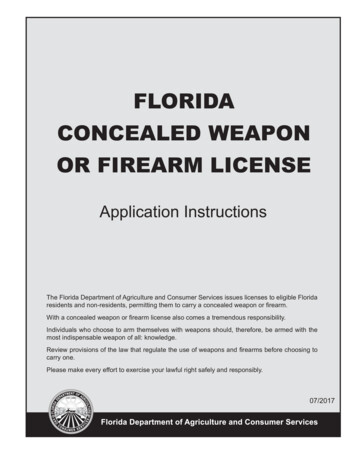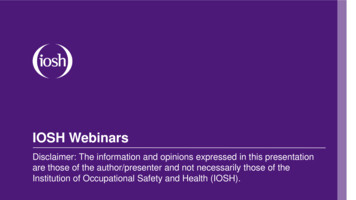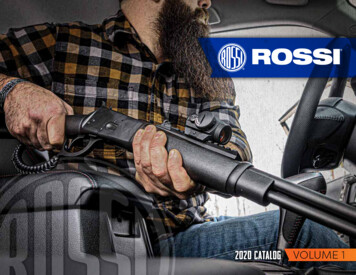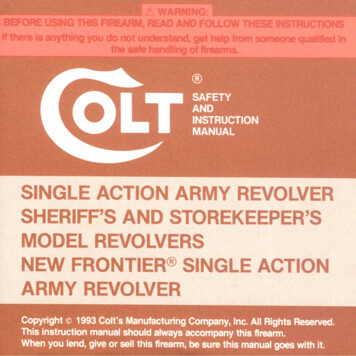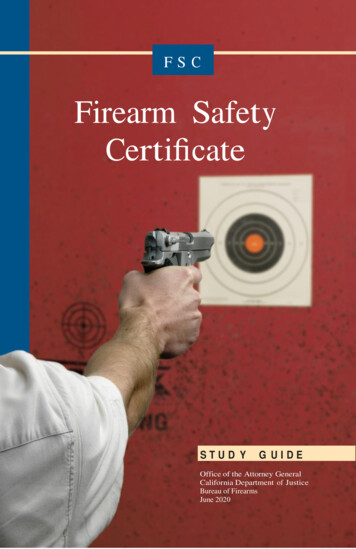
Transcription
FSCFirearm SafetyCertificateSTUD YG UIDEOffice of the Attorney GeneralCalifornia Department of JusticeBureau of FirearmsJune 2020
PrefaceFirearm safety is the law in California. Every firearm ownershould understand and follow firearm safety practices, have abasic familiarity with the operation and handling of theirfirearm, and be fully aware of the responsibility of firearmownership. Pursuant to Penal Code section 26840, any personwho acquires a firearm must have a Firearm Safety Certificate(FSC), unless they are statutorily exempt from the FSCrequirement. To obtain an FSC, a person must pass aDepartment of Justice (DOJ) written test on firearm safety.The test is administered by DOJ Certified Instructors, who areoften located at firearms dealerships.This study guide provides the basic firearm safety informationnecessary to pass the test. Following the firearm safetyinformation in this guide will help reduce the potential foraccidental deaths and injuries, particularly those involvingchildren, caused by the unsafe handling and storing offirearms.In addition to safety information, this study guide provides ageneral summary of the state laws that govern the sale and useof firearms. Finally, there is a glossary that defines the moretechnical terms used in the study guide.Simply reading this study guide will not make you a safefirearm owner. To be a safe firearm owner you must practicethe firearm safety procedures described in the followingpages.
Table of ContentsPrefaceIntroductionWhy Firearm Safety? . . . . . . . . . . . . . . . . . . . . . . . . . . . . . . . . . . . . . . . . 1Firearm Safety is the Law . . . . . . . . . . . . . . . . . . . . . . . . . . . . . . . . . . . . 1Firearm Safety Certificate Information . . . . . . . . . . . . . . . . . . . . . . . . . . 1Causes of Firearm Accidents . . . . . . . . . . . . . . . . . . . . . . . . . . . . . . . . . . 2Preventing Misuse Tragedies . . . . . . . . . . . . . . . . . . . . . . . . . . . . . . . . . . 2Becoming a Safe and Responsible Firearm Owner . . . . . . . . . . . . . . . . . 3Chapter 1: Gun Safety RulesThe Six Basic Gun Safety Rules . . . . . . . . . . . . . . . . . . . . . . . . . . . . . . . 4Additional Safety Points . . . . . . . . . . . . . . . . . . . . . . . . . . . . . . . . . . . . . 6Chapter 1: Self Test . . . . . . . . . . . . . . . . . . . . . . . . . . . . . . . . . . . . . . . . . 7Chapter 2: Firearms and ChildrenFirearm Owner Responsibility . . . . . . . . . . . . . . . . . . . . . . . . . . . . . . . . . 8Summary of Safe Storage Laws Regarding Children . . . . . . . . . . . .8You Cannot Be Too Careful With Children and Guns . . . . . . . . . . .8Talking to Children About Guns . . . . . . . . . . . . . . . . . . . . . . . . . . . 9Instill a Mind Set of Safety and Responsibility . . . . . . . . . . . . . . . . 9Rules for Kids . . . . . . . . . . . . . . . . . . . . . . . . . . . . . . . . . . . . . . . . . . . . . 9Chapter 2: Self Test. . . . . . . . . . . . . . . . . . . . . . . . . . . . . . . . . . . . . . . . . 11Chapter 3: Firearm Operation and Safe HandlingSafe Handling Demonstration . . . . . . . . . . . . . . . . . . . . . . . . . . . . . . . . . 12Revolver Parts and Operation . . . . . . . . . . . . . . . . . . . . . . . . . . . . . . . . . 12How a Revolver Works. . . . . . . . . . . . . . . . . . . . . . . . . . . . . . . . . . . 12Double-Action Revolver Safe Handling. . . . . . . . . . . . . . . . . . . . . . . . . 13Single-Action Revolver Safe Handling . . . . . . . . . . . . . . . . . . . . . . . . . . 15Semiautomatic Pistol Parts and Operation. . . . . . . . . . . . . . . . . . . . . . . . 17How a Semiautomatic Pistol Works. . . . . . . . . . . . . . . . . . . . . . . . . 17Semiautomatic Pistol Safe Handling . . . . . . . . . . . . . . . . . . . . . . . . . . . . 17Long Gun Safe Handling . . . . . . . . . . . . . . . . . . . . . . . . . . . . . . . . . . . . . 21Ammunition . . . . . . . . . . . . . . . . . . . . . . . . . . . . . . . . . . . . . . . . . . . . . . . 25
Ammunition Components . . . . . . . . . . . . . . . . . . . . . . . . . . . . . . . . .25Components of a Cartridge . . . . . . . . . . . . . . . . . . . . . . . . . . . . . . . . 25Physics of Gunfire . . . . . . . . . . . . . . . . . . . . . . . . . . . . . . . . . . . . . . . . . . 25Firearm and Ammunition Calibers . . . . . . . . . . . . . . . . . . . . . . . . . . . . . 26Dangerous Range . . . . . . . . . . . . . . . . . . . . . . . . . . . . . . . . . . . . . . . . . . .27Malfunctions . . . . . . . . . . . . . . . . . . . . . . . . . . . . . . . . . . . . . . . . . . . . . . 27Chapter 3: Self Test . . . . . . . . . . . . . . . . . . . . . . . . . . . . . . . . . . . . . . . . . 28Chapter 4: Firearm OwnershipUnderstand the Safety Aspects of Your Firearm. . . . . . . . . . . . . . . . . . . 29Carefully Read All Instructional Material. . . . . . . . . . . . . . . . . . . . . . . . 29Enroll in a Firearm Training Course . . . . . . . . . . . . . . . . . . . . . . . . . . . . 29Cleaning and Repair. . . . . . . . . . . . . . . . . . . . . . . . . . . . . . . . . . . . . . . . . 29Safety and Storage Devices. . . . . . . . . . . . . . . . . . . . . . . . . . . . . . . . . . . 31Methods of Childproofing . . . . . . . . . . . . . . . . . . . . . . . . . . . . . . . . . . . . 32Chapter 4: Self Test . . . . . . . . . . . . . . . . . . . . . . . . . . . . . . . . . . . . . . . . . 33Prohibited Firearms Transfers and Straw Purchases . . . . 34Chapter 5: Firearms LawsIntroduction to the Laws . . . . . . . . . . . . . . . . . . . . . . . . . . . . . . . . . . . . . 35Sales and Transfers of Firearms . . . . . . . . . . . . . . . . . . . . . . . . . . . . . . . 35New California Resident Requirement . . . . . . . . . . . . . . . . . . . . . . . . . . 38Carrying a Concealed Weapon . . . . . . . . . . . . . . . . . . . . . . . . . . . . . . . . 38Firearms Aboard Common Carriers . . . . . . . . . . . . . . . . . . . . . . . . . . . . 39Firearms in the Home, Business or at the Campsite . . . . . . . . . . . . . . . . 39The Use of Lethal Force in Self-Defense . . . . . . . . . . . . . . . . . . . . . . . . 39Loaded Firearms in Public . . . . . . . . . . . . . . . . . . . . . . . . . . . . . . . . . . . .40Large-Capacity Magazines . . . . . . . . . . . . . . . . . . . . . . . . . . . . . . . . . . . 40Firearm Storage During Prohibition . . . . . . . . . . . . . . . . . . . . . . . . . . . . 40Miscellaneous Prohibited Acts . . . . . . . . . . . . . . . . . . . . . . . . . . . . . . . . 41Persons Ineligible to Possess Firearms . . . . . . . . . . . . . . . . . . . . . . . . . . 43Chapter 5: Self Test . . . . . . . . . . . . . . . . . . . . . . . . . . . . . . . . . . . . . . . . . 44Safe Handling Demonstration Glossary . . . . . . . . . . . . . . . . . . . . . . . . . 45
IntroductionWHY FIREARM SAFETY?Firearm safety is important to all Californians. No one wants firearm accidents tohappen yet they do every day. Firearm accidents involving children areespecially disturbing. Studies show that easy access to loaded firearms in homesis often a contributing factor in accidental shootings of children.While there may be no way to guarantee safety, firearm owners can take steps tohelp prevent many accidental shootings. This study guide will give you valuableinformation to help you become a safe and responsible firearm owner.FIREARM SAFETY IS THE LAWThe intent of the California Legislature in enacting the FSC law is to ensure thatpersons who obtain firearms have a basic familiarity with those firearms, includingbut not limited to, the safe handling and storage of those firearms. It is not the intentof the Legislature to require an FSC for the mere possession of a firearm. (Pen.Code, § 31610.)Firearms must be handled responsibly and securely stored to prevent access bychildren and other unauthorized users. California has strict laws pertaining tofirearms, and you can be fined or imprisoned if you fail to comply with them. Visitthe Web site of the California Attorney General at https://oag.ca.gov/firearms forinformation on firearms laws applicable to you and how you can comply.FIREARM SAFETY CERTIFICATE INFORMATIONTo obtain an FSC, you must take the DOJ written test and receive a passing score ofat least 75% (the information needed to pass the test is contained in this study guide).An FSC is valid for five years from the date of issuance. If your FSC is lost, stolen ordestroyed, a replacement may be obtained from the DOJ Certified Instructor whoissued your original FSC.Pursuant to Penal Code section 31700, there are exemptions from the FSCrequirement including, but not limited to: Federal Firearms License Collectors with a Certificate of Eligibility(for Curio and Relic transactions only); Active, active reserve, or honorably retired military;1
Carry Concealed Weapon (CCW) permit holders; and Persons who have completed Peace Officers Standards and Training(POST)(Pen. Code, § 832) firearms training.For a complete list of exemptions visit the DOJ website at http://oag.ca.gov/firearms orcontact the DOJ Bureau of Firearms, General Information Line at (916) 210-2300. You arerequired to provide documentation of your exemption to the firearms dealer each time youacquire a firearm.E HANDLING DEMONSTRATIONCAUSES OF FIREARM ACCIDENTSIgnorance and carelessness are major causes of firearm accidents. To help reduce thenumber of firearm accidents, it is critical that gun safety rules are understood andpracticed at all times by every family member.Following are some examples of firearm accidents that could have been avoided if the basicgun safety rules had been practiced:Two young children playing in their home found a loaded handgun with themagazine removed on a bedside table. One child was injured when thehandgun was fired.A handgun owner assumed a firearm was unloaded. While cleaning it, heaccidentally fired the handgun, causing injury to himself.A hunter was walking with his finger loosely on the trigger of his rifle.Distracted by a sudden noise behind him, he turned and accidentally fired,injuring his buddy walking nearby.Knowing the safety rules and applying them most of the time is not enough. Firearmaccidents can happen even to a person who knows the safety rules, but is careless infollowing them. For example, you may think you can leave your loaded firearm out on thekitchen table just for a moment while you go outside to turn off the garden hose. Althoughyou know you should never leave a firearm where a child may find it, you carelessly thinkit will be alright “just this once.”REMEMBER: Ignorance and carelessness can result in firearm accidents. Basic gun safetyrules must be applied ALL OF THE TIME.PREVENTING MISUSE TRAGEDIESIt’s a fact that many depressed, intoxicated, substance abusive, or enraged individualscommit suicide every year with firearms, usually handguns. The developmental issuesassociated with adolescence make teenagers particularly susceptible to this unfortunateoutcome. Safe and responsible firearm storage, particularly when a member of thehousehold is experiencing one of the aforementioned conditions, can help preventtragedies.2
BECOMING A SAFE AND RESPONSIBLE FIREARM OWNERBecoming a safe firearm owner is similar to becoming a safe driver—you combine agood working knowledge of the equipment, the basic skills of operation, and a mindset dedicated to safe and responsible usage and storage.This means you must have: Respect for the danger of firearms; An awareness and concern about the possible safety hazards related tofirearms; and A desire to learn and practice safe conduct with firearms.Developing a mind set for safe and responsible firearm usage and storage is the firststep in actually becoming a responsible firearm owner. The next step is buildingyour knowledge of firearms and gun safety, which you can do by reading andunderstanding the information in this study guide. The final steps are becomingskillful in handling firearms and using the safety knowledge that you have acquired.3
CHAPTER 1Gun Safety RulesThis chapter will introduce you to specific gun safety rules to give you a betterunderstanding of firearm safety.THE SIX BASIC GUN SAFETY RULESThere are six basic gun safety rules for gun owners to understand and practice atall times:1. Treat all guns as if they are loaded.2. Keep the gun pointed in the safest possible direction.3. Keep your finger off the trigger until you are ready to shoot.4. Know your target, its surroundings, and beyond.5. Know how to properly operate your gun.6. Store your gun safely and securely to prevent unauthorized use. Guns andammunition should be stored separately.1. Treat all guns as if they are loaded. Always assume that a gun is loaded even if you think it is unloaded. Every time a gun is handled for any reason, check to see that it isunloaded. For specific instructions on how to unload a firearm, seeChapter 3. If you are unable to check a gun to see if it is unloaded, leave it aloneand seek help from someone more knowledgeable about guns.2. Keep the gun pointed in the safest possible direction. Always be aware of where the gun is pointing. A “safe direction” is one where an accidental discharge of the gun will not cause injury or damage. Only point a gun at an object that you intend to shoot. Never point a gun toward yourself or another person.3. Keep your finger off the trigger until you are ready to shoot. Always keep your finger off the trigger and outside the trigger guard untilyou are ready to shoot.4
Even though it may be comfortable to rest your finger on the trigger, it isunsafe. If you are moving around with your finger on the trigger and stumbleor fall, you could inadvertently pull the trigger. Sudden loud noises or movements can result in an accidental dischargebecause there is a natural tendency to tighten the muscles when startled. The trigger is for firing, the handle is for handling.4. Know your target, its surroundings, and beyond. Check that the areas in front of and behind your target are safe beforeshooting. Be aware that if the bullet misses or completely passes through the target, itcould strike a person or object. Identify the target and make sure it is what you intend to shoot. If you are indoubt, DON’T SHOOT! Never fire at a target that is only a movement, color, sound or unidentifiableshape. Be aware of all the people around you before you shoot.5. Know how to properly operate your gun. It is important to become thoroughly familiar with your gun. You should knowits mechanical characteristics including how to properly load, unload and cleara malfunction from your gun. Obviously, not all guns are mechanically the same. Never assume that whatapplies to one make or model is exactly applicable to another. You should direct questions regarding the operation of your gun to yourfirearms dealer, or contact the manufacturer directly.6. Store your gun safely and securely to prevent unauthorized use.Guns and ammunition should be stored separately. Even when the gun is not in your hands, you must still think of safety. Use a California-approved firearms safety device on the gun, such as atrigger lock or cable lock, so it cannot be fired. Store your gun unloaded in a locked container, such as a California-approvedlock box or a gun safe. Store your gun in a different location than the ammunition. For maximum safety you should use both a locking device and a storagecontainer.5
ADDITIONAL SAFETY POINTSThe six basic safety rules are the foundational rules for gun safety. However, thereare additional safety points which must not be overlooked: Never handle a gun when you are in an emotional state such as anger ordepression. Your judgment may be impaired. Never shoot a gun in celebration (such as on the Fourth of July or NewYear’s Eve, for example). Not only is this unsafe, but it is generallyillegal. A bullet fired into the air can return to the ground with enoughspeed to cause injury or death. Do not shoot at water, flat or hard surfaces. The bullet can ricochet and hitsomeone or something other than the target. Hand your gun to someone only after you verify that it is unloaded and thecylinder or action is open. Take a gun from someone only after you verifythat it is unloaded and the cylinder or action is open. Guns, alcohol and drugs don’t mix. Alcohol and drugs can negatively affectjudgment as well as physical coordination. Alcohol and any other substancesare likely to impair normal mental or physical functions and should not beused before or while handling guns. Avoid handling and using your gunwhen you are taking medications that cause drowsiness or include a warningto not operate machinery while taking the drug. The loud noise from a fired gun can cause hearing damage, and the debrisand hot gas that is often emitted can result in eye injury. Always wear earand eye protection when shooting a gun.6
CHAPTER 1:5. As a safety measure, your firearm1. A safe practice when handling ashould always be pointed:(page 4 )gun is to rest your finger on theoutside of the trigger guard oralong the side of the gun untilyou are ready to shoot. (page 4)TrueA. To the north.B. In the safestpossible direction.C. Up.D. Down.False2. To “know your target, itssurroundings and beyond,” youmust consider that if the bulletmisses or completely passesthrough the target, it could strikea person or object. (page 5 )True6. One of the safety rules is to knowhow to properly: (page 5)A.B.C.D.False3. Drinking alcohol whilehandling firearms is safe if yourblood alcohol level remainsbelow the legal limit. (page 6)TrueSelf TestFalse4. Which of the following safetypoints should you rememberwhen handling a gun? (page 6)A. Never shoot a gun incelebration.B. Do not fire at water,flat or hard surfaces.C. Wear ear and eyeprotection when shooting agun.D. All of the above.7Clear a malfunction.Operate your gun.Load your gun.Clean your gun.
CHAPTER 2Firearms and ChildrenFIREARM OWNER RESPONSIBILITYIt is a firearm owner’s responsibility to take all possible steps to make sure achild cannot gain access to firearms. In fact, this responsibility is mandated byCalifornia law. The overall abiding rule is to store your gun in a safe andresponsible manner at all times. As a firearm owner, you should be aware of thelaws regarding children and firearms.Summary of Safe Storage Laws Regarding ChildrenYou may be guilty of a misdemeanor or a felony if you keep a loaded firearm withinany premises that are under your custody or control and a child under 18 years of ageobtains and uses it, resulting in injury or death, or carries it to a public place, unlessyou stored the firearm in a locked container or locked the firearm with a lockingdevice to temporarily keep it from functioning. Please refer to Page 42 for morespecific information regarding safe storage laws related to children.You Cannot Be Too Careful with Children and GunsThere is no such thing as being too careful with children and guns. Never assume thatsimply because a toddler may lack finger strength, they can’t pull the trigger. A child’sthumb has twice the strength of the other fingers. When a toddler’s thumb “pushes”against a trigger, invariably the barrel of the gun is pointing directly at the child’s face.NEVER leave a firearm lying around the house. Please refer to Pages 31 and 32 formore information regarding safe storage and methods of childproofing your firearm.Child safety precautions still apply even if you have no children or if your childrenhave grown to adulthood and left home. A nephew, niece, neighbor’s child or agrandchild may come to visit. Practice gun safety at all times.To prevent injury or death caused by improper storage of guns in a home wherechildren are likely to be present, you should store all guns unloaded, lock them with afirearms safety device and store them in a locked container. Ammunition should bestored in a location separate from the gun.8
Talking to Children about GunsChildren are naturally curious about things they don’t know about or think are“forbidden.” When a child asks questions or begins to act out “gun play,” youmay want to address his or her curiosity by answering the questions as honestlyand openly as possible. This will remove the mystery and reduce the naturalcuriosity. Also, it is important to remember to talk to children in a manner theycan relate to and understand. This is very important, especially when teachingchildren about the difference between “real” and “make-believe.” Let childrenknow that, even though they may look the same, real guns are very different thantoy guns. A real gun will hurt or kill someone who is shot.Instill a Mind Set of Safety and ResponsibilityThe American Academy of Pediatrics reports that adolescence is a highlyvulnerable stage in life for teenagers struggling to develop traits of identity,independence and autonomy. Children, of course, are both naturally curiousand innocently unaware of many dangers around them. Thus, adolescents aswell as children may not be sufficiently safeguarded by cautionary words,however frequent contrary actions can completely undermine good advice. A“do as I say and not as I do” approach to gun safety is both irresponsible anddangerous.Remember that actions speak louder than words. Children learn most byobserving the adults around them. By practicing safe conduct you will also beteaching safe conduct.RULES FOR KIDSAdults should be aware that a child could discover a gun when a parent or anyother adult is not present. This could happen in the child’s own home; thehome of a neighbor, friend or relative; or in a public place such as a school orpark. If this should happen, a child should know the following rules and betaught to practice them.1. StopThe first rule for a child to follow if he/she finds or sees a gun is to stopwhat he/she is doing.2. Don’t Touch!The second rule is for a child not to touch a gun he/she finds or sees. A child maythink the best thing to do if he/she finds a gun is to pick it up and take it to anadult. A child needs to know he/she should NEVER touch a gun he/she may find orsee.3. Leave the AreaThe third rule is to immediately leave the area. This would include never taking agun away from another child or trying to stop someone from using gun.9
4. Tell an AdultThe last rule is for a child to tell an adult about the gun he/she has seen.This includes times when other kids are playing with or shooting a gun.Please note that, while there is no better advice at this time for children oradolescents who encounter a gun by happenstance, the California Chapter ofthe American College of Emergency Physicians reports that such warnings alonemay be insufficient accident prevention measures with children and adolescents.10
CHAPTER 2:Self Test5. The four safety “Rules for Kids”1. Toddlers lack the strength to pullthe trigger of a firearm. (page 8)if they see a gun are: (page 9)TrueA.B.C.D.False2. You may face misdemeanor orfelony charges if you keep aloaded firearm where a childobtains and improperly usesit. (page 8)True6. Child safety precautionsonly apply if you havechildren. (page 8)FalseTrue3. There is no such thing as beingtoo careful with children andguns. (page 8)TrueFalse4. An important lesson childrenshould learn is that guns arenot toys. (page 9)TrueFalse11False
CHAPTER 3Firearm Operationand Safe HandlingSAFE HANDLING DEMONSTRATIONPursuant to Penal Code sections 26850 and 26860, prior to taking delivery of afirearm from a licensed firearms dealer in California, an individual must correctlyperform a safe handling demonstration with the firearm he or she is acquiring. Thesafe handling demonstration must be performed in the presence of a DOJ CertifiedInstructor on or after the date the Dealer Record of Sale (DROS) is submitted to theDOJ and before the firearm is delivered. This section lists each of the steps thatconstitute the statutorily mandated safe handling demonstrations for the mostcommon handgun types (semiautomatic pistols, double-action revolvers and singleaction revolvers). This section also includes safe handling demonstration steps formost long gun types. However, this information will not appear on the DOJ writtentest on firearm safety. Please note that a dummy round as stated in this guide refers toone bright orange, red or other readily identifiable dummy round. If no readilyidentifiable dummy round is available, an empty cartridge casing with an emptyprimer pocket may be used.The safe handling demonstration shall commence with the firearm unloaded andlocked with the firearm safety device with which it is required to be delivered, ifapplicable. While maintaining muzzle awareness (that is, the firearm is pointed in asafe direction, preferably down at the ground) and trigger discipline (that is, thetrigger finger is outside of the trigger guard and alongside of the firearm frame) atall times, the firearm recipient shall correctly and safely perform the safe handlingdemonstration steps for each firearm type.REVOLVER PARTS AND OPERATIONHow a Revolver WorksA revolver has a rotating cylinder containing a number of chambers. There are usuallyfive or six chambers. The action of the trigger or hammer will line up a chamber withthe barrel and firing pin. Releasing the cylinder latch allows the cylinder to swing outfor loading, unloading and inspection.Revolvers are either single or double-action. The primary difference between thesetwo types of revolvers is the function of the trigger. On a single-action revolver thetrigger has a single function to release the hammer. The trigger on a double- actionrevolver has two functions to cock the hammer and to release it.12
SDOUBLE-ACTION REVOLVER SAFE HANDLINGbarrelcylinderhammercylinderlatchejector rodtriggertrigger guardgrip1.Open the cylinder.2.Visually and physically inspect eachchamber to ensure that the revolver isunloaded.3. Remove the firearm safety device.If the firearm safety deviceprevents any of the previous steps,remove the firearm safety deviceduring the appropriate step.13
4.5.While maintaining muzzleawareness and trigger discipline,load one dummy round into achamber of the cylinder and rotatethe cylinder so that the round is inthe next-to-fire position.Close the cylinder.6.Open the cylinder and eject theround.7.Visually and physicallyinspect each chamber toensure that the revolver isunloaded.8.Apply the firearm safetydevice, if applicable.NOTE: Simply spinning a revolver to an empty chamber does not unload it or makeit safe. The cylinder rotates to the next chamber before the hammer falls.14
SINGLE-ACTION REVOLVER SAFE HANDLING.barrelcylinderhammerfirearm safety devicegrip1.Open the loading gate.2.15Visually and physically inspecteach chamber to ensure that therevolver is unloaded.
3.4.5.Remove the firearm safety devicerequired to be sold with thefirearm. If the firearm safetydevice prevents any of theprevious steps, remove the firearmsafety device during theappropriate step.6.Visually and physically inspect eachchamber to ensure that the revolver isunloaded.7.Apply the firearm safety device, ifapplicable.*1873 Rule: Recipients of originalversions of single-action armyrevolvers should be advised tocarry five rounds in the cylinderand leave the chamber underthe hammer empty.Load one dummy round into achamber of the cylinder, closethe loading gate and rotate thecylinder so that the round is inthe next-to-fire position (therevolver may need to be placedon half-cock or the loadinggate reopened).Open the loading gate andunload the revolver.16
SEMIAUTOMATIC PISTOL PARTS AND OPERATIONHow a Semiautomatic Pistol WorksA semiautomatic pistol has a single chamber. Each time the trigger is pulled, acartridge is fired, the empty case is automatically extracted and ejected, thehammer is cocked, and a new cartridge is loaded into the chamber.The primary difference between revolvers and semiautomatic pistols is how theammunition is held. Revolvers use a cylinder to hold ammunition. Semiautomaticpistols use a magazine to hold ammunition. A magazine is a separate metal boxlikecontainer into which cartridges are loaded. It is usually located within the grip. Abutton or catch releases the magazine.Another difference is most semiautomatic pistols have a “safety” that is designed toprevent firing when engaged. However, it is not foolproof so do not rely on thesafety to prevent an accidental discharge. A safety should be considered anadditional safety measure.Never pull the trigger on any firearm with the safety in the “safe” positionbecause thereafter the firearm could fire at any time without the trigger ever beingtouched. If a firearm is dropped, it may land hard enough to activate the firingmechanism without the trigger being touched.SEMIAUTOMATIC PISTOL SAFE HANDLINGslideslide nereleasegrip17magazine
1.Remove the magazine.4.Remove the firearm safetydevice, if applicable. If the firearmsafety device prevents any of theprevious steps, remove the firearmsafety device during theappropriate step.2.Lock the slide back. If the modelof firearm does not allow the slideto be locked back, pull the slideback, visually and physicallyinspect the chamber to ensure thatit is clear.5.Load one dummy round into themagazine.6.Insert the magazine into themagazine well of the firearm.3.Visually and physically inspect thechamber, to ensure that thefirearm is unloaded.18
7.Manipulate the slide release orpull back and release the slide.8.Remove the magazine.10.Lock the slide back to ejectthe dummy round. If the firearm isof a model that does not allow theslide to be locked back, pull theslide back and physically check thechamber to ensure that the chamberis clear.11. Apply the safety, if applicable.9.Visually inspect the chamber toreveal that a round can bechambered with the magazineremoved.12.19Apply the firearm safety device,if appl
This study guide provides the basic firearm safety information necessary to pass the test. Following the firearm safety information in this guide will help reduce the potential for accidental deaths and injuries, particularly those involving childre
